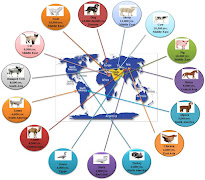The role of animal and crop translocation in animal domestication in Europe
The domestication of animals was a key event in human history, contributing to the development of agriculture and settled societies. The process of domestication began in different parts of the world at different times, but it is generally believed to have begun in Europe around 10,000 years ago.
One of the key factors that played a role in the domestication of animals in Europe was the transmigration of animals and crops. This means that animals and crops were moved from one place to another, often over long distances. This translocation had a number of consequences that made it easier for humans to domesticate animals.
1. Translocation allowed people to bring animals closer to them.
This made it easier for humans to observe and control animals, and to provide them with food and water. It also made it easier for people to select animals with desirable traits such as tameness and docility.
2. Translocation allowed humans to introduce new animals into new environments.
It can be beneficial for both animals and humans. For example, in some cases animals were introduced to a new environment where it was easier for them to find food. In other cases, animals were introduced to new environments where they could assist humans in tasks such as hunting or transportation.
3. Translocation allowed people to mix different breeds of animals.
This could create new breeds of animals with desirable traits. For example, by crossing different breeds of cattle, people were able to create breeds that were better suited for different purposes, such as milk or meat production.
Evidence:
There is much evidence to support the role of animal and crop translocation in the domestication of animals in Europe. This evidence comes from a variety of sources, including archaeological, genetic, and historical data.
Archaeological evidence suggests that animals and crops were moved across Europe from very early times. For example, archaeologists have found evidence of the migration of cattle, sheep and pigs to Europe as early as 8,000 years ago.
Genetic evidence also supports the role of translocation in animal domestication. For example, genetic studies have shown that European cattle are descended from a single population of wild bison domesticated in the Middle East. This suggests that cattle were moved from the Middle East to Europe.
Historical evidence also supports the role of translocation in animal domestication. For example, Roman records show that the Romans moved animals across Europe as early as the 1st century AD.
The transmigration of animals and crops played a key role in the domestication of animals in Europe. This translocation allowed humans to bring animals closer to them, to introduce new animals to new environments, and to mix different breeds of animals. All these factors made it easier for people to domesticate animals and develop a more sedentary lifestyle.




Comments
Post a Comment